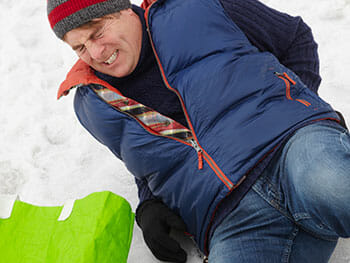
Winter has its own special set of challenges. One of many is walking safely when you suspect ice might be underfoot. It’s not always possible to spot the stuff, as anyone who has ever skidded on “black ice” can readily attest. Ice can cause serious falls, resulting in broken bones and nasty gashes, and even injuries to internal organs, the spinal cord, and the brain.
Maryland has some fairly specific laws and legal precedents when it comes to determining fault with regard to falls, especially when slipping and falling happen because of ice.
Maryland Law: The Fault System
In Maryland, determining fault in slip-and-fall cases depends on a reasonably narrow reading of who is at fault and whether any risk was knowingly assumed on the part of the victim. Business owners are often liable for damages if you slip and fall on their premises if there was:
- A long-standing hazard they knew about and did nothing to correct
- A long-standing hazard they did not warn you about (signage and other means)
- A long-standing hazard that they should have known about, but didn’t.
Another factor, however, also comes into play. If even a small amount of fault could be attributed to you, then you cannot collect damages under what’s known as pure contributory negligence. (Maryland is one of four states and the District of Columbia that follow this legality.) Related to pure contributory negligence is assumption of risk, which means that you willingly and voluntarily assumed a known risk.
But If Ice Is Involved . . .
Ice, legally speaking, brings its own special set of challenges and rulings, especially when it comes to both black ice and landlords.
Pure contributory negligence and assumption of risk would appear to dictate that, if you could have reasonably expected ice, or if you saw ice, then you would be considered partially at fault. Therefore, the case would likely be dismissed if you fell and then brought a suit. However, with black ice, because you can’t see it and don’t expect it, then the case would likely not be dismissed and you’d have a decent chance of winning. The precedent for black ice comes from two 2011 cases, when Maryland’s highest court set aside black ice cases as different from other slip-and-fall cases. The reason for the court’s decision is that the person who fell could not be assumed to know that the black ice existed should the facts of the matter be in dispute.
Landlords have a special set of circumstances when it comes to ice because it depends on whose legal responsibility it is to shovel the snow and melt the ice. Often, it depends on the language in a lease. If the lease says the landlord must remove snow and ice, then the landlord is responsible for doing so in a timely fashion. If the landlord does not remove snow and ice, and you injure yourself falling on, for example, a sidewalk that’s part of the rental property, then you may well have a case. Even if the landlord does not live on site or even in the same state, he or she is responsible if the lease states that they are. This would apply to them regardless of whether you mentioned the need for snow and ice removal to them and you were then injured in a fall.
How Can “The Injury Lawyer” Help You?
At the Law Offices of Steven H. Heisler, we know how traumatic an injury from a serious fall can be for both the injured person and for his or her family. If you or a family member has suffered from a fall or other injury due to icy, slippery conditions, call Baltimore personal injury attorney Steve Heisler. Keep in mind, however, that there is a statute of limitations – or a time limit – for filing personal injury claims. If you have been injured in an accident or have otherwise incurred a personal injury, you should not delay. Contact the Law Offices of Steven H. Heisler of Baltimore, Maryland, for a free initial consultation by calling (410) 625-4878 today.
